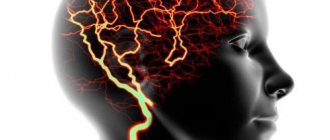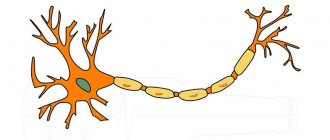Etiology
The main feature of the hallucinatory syndrome is that the person retains clear consciousness. If auditory, visual, or tactile hallucinations develop against the background of clouding of consciousness, this condition is not called hallucinosis.
There is a possibility of both an isolated development of pathology, for example, Charles Bonnet hallucinosis, which occurs in elderly people, and the formation of the disease against the background of the course of some mental or organic (organic hallucinosis) diseases.
The most common causes of hallucinosis:
- epilepsy - hallucinations indicate an approaching attack, and a distinctive feature is the predominance of blue and scarlet shades in a non-existent picture;
- traumatic brain injuries;
- pathologies of the central nervous system;
- cystic, malignant or benign formations in the brain;
- schizophrenia and one of its varieties - hebephrenia;
- severe infections;
- encephalitis;
- withdrawal syndrome;
- intracranial hemorrhage.
Not the last place in the formation of such a disorder is occupied by many years of addiction to bad habits or chronic alcoholism. In such cases, acute alcoholic hallucinosis develops.
Atypical acute hallucinosis
Such hallucinations in alcoholism can have different development options. Each form is characterized by certain manifestations.
With oneiric stupefaction
Oneiroid is a mental disorder in which real and imaginary events intertwine in the patient’s head. A person experiences a loss of identification; he feels like a participant in unreal events.
The main symptoms of the pathology include anxiety attacks. Then auditory hallucinations arise, which transform into powerful delusions. An alcoholic imagines unrealistic stories - cataclysms or alien travel.
With stuporous disorders
This disorder is characterized by a state of alcoholic stupor - immobility. This form of pathology is diagnosed very rarely.
Hallucinosis with stuporous disorders is characterized by alcoholic stupor, which is diagnosed quite rarely
The state of stupor against the background of complex alcoholism does not arise immediately. It appears only at the peak of psychosis. At this moment, the patient freezes in place and practically does not react to others. Sometimes a combination of stupor and oneiric seizures is observed. This condition may be present from 2 minutes to several hours.
With mental automatisms
In this case, it seems to the patient that his thoughts and emotions are imposed on him by some external forces. Like other atypical syndromes, automatisms appear at the peak of hallucinosis.
This condition may be accompanied by symptoms of oneiroid and delirium. The person also experiences active delirium. These symptoms increase in the evening and at night. In the acute form of the disease, a person develops open-mindedness syndrome. It seems to him that all his thoughts are known to others.
Classification
According to the variant of the course, clinicians usually distinguish:
- Acute hallucinosis. Characteristic symptoms occur suddenly against the background of normal general health. There is a prodromal period lasting from several hours to a couple of days.
- Subacute form. Before hallucinations, a person experiences unreasonable fear and an unreasonable feeling of anxiety. Irritability, frequent mood swings and depression are noted.
- Chronic hallucinosis. It is considered an extremely rare form, the duration of which is from 2 to 10 or more years. Those situations where hallucinations do not go away for 6 months speak specifically about the chronic course of the pathological process. In most cases, the cause of the anomaly is psychosis.
Depending on the clinical picture, there are:
- Peduncular syndrome or Lhermitte's hallucinosis. A consequence of diseases of vascular origin, neoplasms, injuries or infectious lesions of the brain.
- Visual hallucinosis of Charles Bonnet. Develops in mentally healthy people with vision problems. Most often, this type of anomaly is diagnosed in older people. The peculiarity of this type of illness is that the hallucinations are not directed at the patient himself.
- Van Bogaert visual hallucinosis. Manifests itself in a large number of bright images of small sizes. These could be flowers, butterflies or birds.
- Verbal hallucinosis. Characterized by the appearance of auditory hallucinations. There can be one or several voices (they can conduct an active conversation or argument). Often leads to sleep disorders.
- Olfactory hallucinosis syndrome or Gobeck's disease. It is considered the rarest type and mainly acts as one of the clinical manifestations of schizophrenia.
- Tactile hallucinosis. It has a large number of manifestations, but most patients complain of pins and needles on the skin, burning and itching. Signs may even appear during sleep. Very rarely do people talk about insects inside their own body - in such cases we are talking about a visceral form of the disease.
- Plaut's hallucinosis. A combination of several types of hallucinations, particularly verbal sensations and delusions. A combination of visual and olfactory disorders occurs in isolated cases. This form is registered as a companion to brain syphilis.
Based on the etiological factor, there is the following hallucinatory-paranoid syndrome:
- Organic hallucinosis. Associated with brain pathologies, symptoms depend on location. May be accompanied by disorders such as morphopsia, depersonalization, derealization and sleep disturbance.
- Atherosclerotic type. Based on the name, it becomes clear that the main provocateur is atherosclerosis. It occurs only in a chronic form, as a result of which the symptoms will increase gradually. It is noteworthy that it is most often diagnosed in women.
- Alcoholic hallucinosis or hallucinatory insanity of drunken people. Often occurs when giving up alcohol during treatment for somatic disorders. Rarely forms directly during binge drinking.
It is customary to distinguish hallucinatory-paranoid syndrome and hallucinatory-delusional syndrome. The first variety combines the following forms:
- paranoid;
- paraphrenic;
- paranoid;
- Kandinsky-Clerambault syndrome.
All options can occur in isolation, but are often considered as stages in the course of one mental disorder. However, paranoid peduncular syndrome is of a secondary nature.
Mixed acute hallucinosis
Such pathologies may be accompanied by severe delirium or combined with delirium. Each variety is characterized by certain manifestations.
With pronounced delirium
The key symptom of hallucinogenic syndrome is a combination of single auditory hallucinations and severe persecutory delusions. Affective disturbances indicate the onset of psychosis. A person experiences a feeling of depression, a rapid increase in anxiety, and then fear appears.
Hallucinoses with severe delusions include persecutory delusions along with other types of hallucinations
After this, the alcoholic experiences auditory hallucinations. Almost immediately, delusional thoughts join in. All this combines into one theory of persecution. However, sometimes there are individual thoughts that have no logic.
When carrying out therapy, it is first possible to cope with mood disorders, then auditory hallucinations disappear, and only lastly delusional ideas are eliminated. Quite often, patients experience residual delirium.
With delirium
This disorder is characterized not only by auditory hallucinations, but also by the classic symptoms of delirium tremens, which is medically called delirium. In this case, a person experiences panic attacks, a feeling of anxiety, and sleep disturbances.
Autonomic disorders also occur, which manifest themselves in the form of tremor, increased blood pressure, and tachycardia. People with this diagnosis experience vivid hallucinations and delusions.
Such signs may appear suddenly. Most often this happens at night. The main symptom of the disorder is auditory hallucinations. However, sometimes people imagine various pictures or touches.
Symptoms
Each type of disease will have a different clinical picture. For example, Charles Bonnet syndrome is characterized by:
- hallucinations in the form of cartoons;
- the appearance of people with distorted facial features;
- spontaneous appearance and disappearance of visions;
- complete safety of the image.
Lhermitte's disease is expressed by the following manifestations:
- the appearance of non-existent pictures in the dark;
- hallucinations in the form of blurry figures of people or animals;
- maintaining criticism regarding one's condition.
Verbal hallucinosis is characterized by:
- hearing one or more non-existent voices;
- their discussion of the patient and his environment;
- a person performing actions that the voice ordered him to do;
- the appearance of a condition such as hallucinatory-paranoid syndrome, in which criticism of one’s condition is lost.
The following symptoms are present in alcoholic hallucinosis:
- increased anxiety;
- causeless fear;
- vivid and believable optical illusions;
- the appearance of voices from walls or objects;
- the occurrence of obsessive thoughts regarding one’s own death or the death of relatives;
- sleep disorder;
- attempts to independently settle accounts with life.
Signs of alcoholic hallucinosis
Subacute hallucinosis
This diagnosis is given to people who have mental disorders for 1 to 6 months. Most often, such deviations are observed for 2-3 months. The onset of the attack resembles ordinary hallucinogenic psychosis. But subsequently, other disorders are added to the auditory deceptions.
Subacute hallucinosis occurs in advanced disease
With a predominance of verbal hallucinations
This type of pathology is very rare. Initially, a person experiences affective disorders. After which visual and auditory hallucinations appear and symptoms of delirium occur.
Diagnostics
Diagnosing hallucinosis is not particularly difficult for an experienced neurologist. The process of establishing the correct diagnosis is often limited to the following actions:
- studying family medical history;
- familiarization with the clinical history - to identify mental, organic or somatic diseases;
- collection and analysis of life history;
- performing specific neurological tests;
- a detailed survey of the patient and his relatives - to compile a complete symptomatic picture, determine the time of appearance and severity of symptoms, which will help to distinguish between acute and chronic hallucinosis.
Additional laboratory and instrumental examinations are necessary only in the case of secondary development of hallucinosis. The factor causing such a condition as organic hallucinosis is accurately determined.
Treatment
Chronic and acute hallucinosis are treated using conservative techniques aimed at the following results:
- detoxification of the body - for chronic alcoholism;
- neutralization of psychotic phenomena;
- normalization of the functioning of internal organs and systems;
- prevention of the development of persistent cognitive impairment, which often accompanies hallucinatory-paranoid syndrome.
Drug therapy consists of taking the following medications:
- neuroleptics;
- ascorbic acid;
- B vitamins;
- saline solutions for intravenous administration;
- sedatives;
- antidepressants;
- tranquilizers - eliminate hallucinations.
Long-term work of a psychiatrist with a sick person is necessary.
Treatment of organic hallucinosis is purely individual - it can be either conservative or surgical. The etiological factor dictates the treatment tactics.
Prevention and prognosis
You can avoid the development of verbal hallucinosis and other forms of the disease by following simple preventive recommendations:
- complete cessation of bad habits, in particular drinking alcohol;
- avoiding organic brain damage;
- timely and complete treatment of atherosclerosis and other diseases leading to the formation of hallucinatory syndrome;
- Regularly undergoing a full preventive examination at the clinic.
The prognosis for hallucinosis is ambiguous. On the one hand, the outcome is positive, but only with early diagnosis of the pathology with complete elimination of the etiological factor and complete treatment. On the other hand, the complete absence of therapy leads to the fact that a person becomes dangerous not only to himself, but also to others.
The possibility of suicide attempts cannot be ruled out. The most unfavorable prognosis is observed with the development of delusional and hallucinatory-paranoid syndromes.
What to do?
If you think you have Hallucinosis
and hallucinations, symptoms characteristic of this disease, then doctors can help you: a neurologist, a psychiatrist, a psychotherapist.
Source
Did you like the article? Share with friends on social networks:











